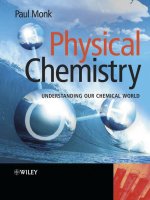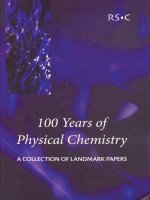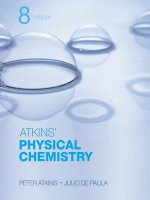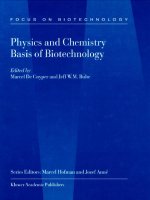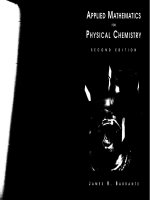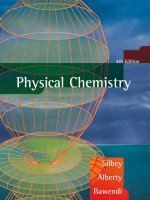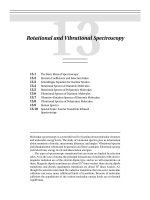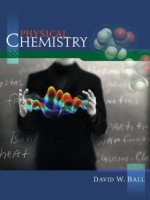physical chemistry peter atkins, julio de paula
Bạn đang xem bản rút gọn của tài liệu. Xem và tải ngay bản đầy đủ của tài liệu tại đây (13.01 MB, 1,087 trang )
ATKINS’
PHYSICAL
CHEMISTRY
This page intentionally left blank
ATKINS’
PHYSICAL
CHEMISTRY
Eighth Edition
Peter Atkins
Professor of Chemistry,
University of Oxford,
and Fellow of Lincoln College, Oxford
Julio de Paula
Professor and Dean of the College of Arts and Sciences
Lewis and Clark College,
Portland, Oregon
W. H. Freeman and Company
New York
Library of Congress Control Number: 2005936591
Physical Chemistry, Eighth Edition
© 2006 by Peter Atkins and Julio de Paula
All rights reserved
ISBN: 0-7167-8759-8
EAN: 9780716787594
Published in Great Britain by Oxford University Press
This edition has been authorized by Oxford University Press for sale in the
United States and Canada only and not for export therefrom.
First printing
W. H. Freeman and Company
41 Madison Avenue
New York, NY 10010
www.whfreeman.com
Preface
We have taken the opportunity to refresh both the content and presentation of this
text while—as for all its editions—keeping it flexible to use, accessible to students,
broad in scope, and authoritative. The bulk of textbooks is a perennial concern: we
have sought to tighten the presentation in this edition. However, it should always be
borne in mind that much of the bulk arises from the numerous pedagogical features
that we include (such as Worked examples and the Data section), not necessarily from
density of information.
The most striking change in presentation is the use of colour. We have made every
effort to use colour systematically and pedagogically, not gratuitously, seeing as a
medium for making the text more attractive but using it to convey concepts and data
more clearly. The text is still divided into three parts, but material has been moved
between chapters and the chapters have been reorganized. We have responded to the
shift in emphasis away from classical thermodynamics by combining several chapters
in Part 1 (Equilibrium), bearing in mind that some of the material will already have
been covered in earlier courses. We no longer make a distinction between ‘concepts’
and ‘machinery’, and as a result have provided a more compact presentation of ther-
modynamics with less artificial divisions between the approaches. Similarly, equilib-
rium electrochemistry now finds a home within the chapter on chemical equilibrium,
where space has been made by reducing the discussion of acids and bases.
In Part 2 (Structure) the principal changes are within the chapters, where we have
sought to bring into the discussion contemporary techniques of spectroscopy and
approaches to computational chemistry. In recognition of the major role that phys-
ical chemistry plays in materials science, we have a short sequence of chapters on
materials, which deal respectively with hard and soft matter. Moreover, we have
introduced concepts of nanoscience throughout much of Part 2.
Part 3 has lost its chapter on dynamic electrochemistry, but not the material. We
regard this material as highly important in a contemporary context, but as a final
chapter it rarely received the attention it deserves. To make it more readily accessible
within the context of courses and to acknowledge that the material it covers is at home
intellectually with other material in the book, the description of electron transfer
reactions is now a part of the sequence on chemical kinetics and the description of
processes at electrodes is now a part of the general discussion of solid surfaces.
We have discarded the Boxes of earlier editions. They have been replaced by more
fully integrated and extensive Impact sections, which show how physical chemistry is
applied to biology, materials, and the environment. By liberating these topics from
their boxes, we believe they are more likely to be used and read; there are end-of-
chapter problems on most of the material in these sections.
In the preface to the seventh edition we wrote that there was vigorous discussion in
the physical chemistry community about the choice of a ‘quantum first’ or a ‘thermo-
dynamics first’ approach. That discussion continues. In response we have paid particu-
lar attention to making the organization flexible. The strategic aim of this revision
is to make it possible to work through the text in a variety of orders and at the end of
this Preface we once again include two suggested road maps.
The concern expressed in the seventh edition about the level of mathematical
ability has not evaporated, of course, and we have developed further our strategies
for showing the absolute centrality of mathematics to physical chemistry and to make
it accessible. Thus, we give more help with the development of equations, motivate
vi PREFACE
them, justify them, and comment on the steps. We have kept in mind the struggling
student, and have tried to provide help at every turn.
We are, of course, alert to the developments in electronic resources and have made
a special effort in this edition to encourage the use of the resources on our Web site (at
www.whfreeman.com/pchem8) where you can also access the eBook. In particular,
we think it important to encourage students to use the Living graphs and their con-
siderable extension as Explorations in Physical Chemistry. To do so, wherever we
call out a Living graph (by an icon attached to a graph in the text), we include an
Exploration in the figure legend, suggesting how to explore the consequences of
changing parameters.
Overall, we have taken this opportunity to refresh the text thoroughly, to integrate
applications, to encourage the use of electronic resources, and to make the text even
more flexible and up to date.
Oxford P.W.A.
Portland J.de P.
PREFACE vii
About the book
There are numerous features in this edition that are designed to make learning phys-
ical chemistry more effective and more enjoyable. One of the problems that make the
subject daunting is the sheer amount of information: we have introduced several
devices for organizing the material: see Organizing the information. We appreciate
that mathematics is often troublesome, and therefore have taken care to give help with
this enormously important aspect of physical chemistry: see Mathematics and Physics
support. Problem solving—especially, ‘where do I start?’—is often a challenge, and
we have done our best to help overcome this first hurdle: see Problem solving. Finally,
the web is an extraordinary resource, but it is necessary to know where to start, or
where to go for a particular piece of information; we have tried to indicate the right
direction: see About the Web site. The following paragraphs explain the features in
more detail.
Organizing the information
Checklist of key ideas
Here we collect together the major concepts introduced in the
chapter. We suggest checking off the box that precedes each
entry when you feel confident about the topic.
Impact sections
Where appropriate, we have separated the principles from
their applications: the principles are constant and straightfor-
ward; the applications come and go as the subject progresses.
The Impact sections show how the principles developed in
the chapter are currently being applied in a variety of modern
contexts.
Checklist of key ideas
1. A gas is a form of matter that fills any container it occupies.
2. An equation of state interrelates pressure, volume,
temperature, and amount of substance: p = f(T,V,n).
3. The pressure is the force divided by the area to which the force
is applied. The standard pressure is p
7
= 1 bar (10
5
Pa).
4. Mechanical equilibrium is the condition of equality of
pressure on either side of a movable wall.
5. Temperature is the property that indicates the direction of the
flow of energy through a thermally conducting, rigid wall.
6. A diathermic boundary is a boundary that permits the passage
of energy as heat. An adiabatic boundary is a boundary that
prevents the passage of energy as heat.
7. Thermal equilibrium is a condition in which no change of
state occurs when two objects A and B are in contact through
a diathermic boundary.
8. The Zeroth Law of thermodynamics states that, if A is in
thermal equilibrium with B, and B is in thermal equilibrium
with C, then C is also in thermal equilibrium with A.
9. The Celsius and thermodynamic temperature scales are
related by T/K =
θ
/°C + 273.15.
10. A perfect gas obeys the perfect gas equation, pV = nRT, exactly
12. The partial pressure of any gas
i
x
J
= n
J
/n is its mole fraction in
a
pressure.
13. In real gases, molecular interac
t
state; the true equation of state
i
coefficients B, C, : pV
m
= R
T
14. The vapour pressure is the pres
s
with its condensed phase.
15. The critical point is the point a
t
end of the horizontal part of th
e
a single point. The critical cons
t
pressure, molar volume, and te
m
critical point.
16. A supercritical fluid is a dense
fl
temperature and pressure.
17. The van der Waals equation of
s
the true equation of state in wh
i
by a parameter a and repulsion
s
parameter b: p = nRT/(V
−
nb)
−
18. A reduced variable is the actual
corresponding critical constant
IMPACT ON NANOSCIENCE
I20.2 Nanowires
We have already remarked (Impacts I9.1, I9.2, and I19.3) that research on nano-
metre-sized materials is motivated by the possibility that they will form the basis for
cheaper and smaller electronic devices. The synthesis of nanowires, nanometre-sized
atomic assemblies that conduct electricity, is a major step in the fabrication of
nanodevices. An important type of nanowire is based on carbon nanotubes, which,
like graphite, can conduct electrons through delocalized
π
molecular orbitals that
form from unhybridized 2p orbitals on carbon. Recent studies have shown a cor-
relation between structure and conductivity in single-walled nanotubes (SWNTs)
that does not occur in graphite. The SWNT in Fig. 20.45 is a semiconductor. If the
hexagons are rotated by 60° about their sixfold axis, the resulting SWNT is a metallic
conductor.
Carbon nanotubes are promising building blocks not only because they have useful
electrical properties but also because they have unusual mechanical properties. For
example, an SWNT has a Young’s modulus that is approximately five times larger and
a tensile strength that is approximately 375 times larger than that of steel.
Silicon nanowires can be made by focusing a pulsed laser beam on to a solid target
composed of silicon and iron. The laser ejects Fe and Si atoms from the surface of the
ABOUT THE BOOK ix
Notes on good practice
Science is a precise activity and its language should be used
accurately. We have used this feature to help encourage the use
of the language and procedures of science in conformity to
international practice and to help avoid common mistakes.
Justifications
On first reading it might be sufficient to appreciate the ‘bottom
line’ rather than work through detailed development of a
mathematical expression. However, mathematical develop-
ment is an intrinsic part of physical chemistry, and it is
important to see how a particular expression is obtained. The
Justifications let you adjust the level of detail that you require to
your current needs, and make it easier to review material.
Molecular interpretation sections
Historically, much of the material in the first part of the text
was developed before the emergence of detailed models of
atoms, molecules, and molecular assemblies. The Molecular
interpretation sections enhance and enrich coverage of that
material by explaining how it can be understood in terms of
the behaviour of atoms and molecules.
q
A note on good practice We write T = 0, not T = 0 K for the zero temperature
on the thermodynamic temperature scale. This scale is absolute, and the lowest
temperature is 0 regardless of the size of the divisions on the scale (just as we write
p = 0 for zero pressure, regardless of the size of the units we adopt, such as bar or
pascal). However, we write 0°C because the Celsius scale is not absolute.
5.8 The activities of regular solutions
The material on regular solutions presented in Section 5.4 gives further insight into
the origin of deviations from Raoult’s law and its relation to activity coefficients. The
starting point is the expression for the Gibbs energy of mixing for a regular solution
(eqn 5.31). We show in the following Justification that eqn 5.31 implies that the activ-
ity coefficients are given by expressions of the form
ln
γ
A
=
β
x
B
2
ln
γ
B
=
β
x
A
2
(5.57)
These relations are called the Margules equations.
Justification 5.4 The Margules equations
The Gibbs energy of mixing to form a nonideal solution is
∆
mix
G = nRT{x
A
ln a
A
+ x
B
ln a
B
}
This relation follows from the derivation of eqn 5.31 with activities in place of mole
fractions. If each activity is replaced by
γ
x, this expression becomes
∆
mix
G = nRT{x
A
ln x
A
+ x
B
ln x
B
+ x
A
ln
γ
A
+ x
B
ln
γ
B
}
Now we introduce the two expressions in eqn 5.57, and use x
A
+ x
B
= 1, which gives
∆
mix
G = nRT{x
A
ln x
A
+ x
B
ln x
B
+
β
x
A
x
B
2
+
β
x
B
x
A
2
}
= nRT{x
A
ln x
A
+ x
B
ln x
B
+
β
x
A
x
B
(x
A
+ x
B
)}
= nRT{x
A
ln x
A
+ x
B
ln x
B
+
β
x
A
x
B
}
as required by eqn 5.31. Note, moreover, that the activity coefficients behave cor-
rectly for dilute solutions:
γ
A
→ 1 as x
B
→ 0 and
γ
B
→ 1 as x
A
→ 0.
Molecular interpretation 5.2 The lowering of vapour pressure of a solvent in a mixture
The molecular origin of the lowering of the chemical potential is not the energy of
interaction of the solute and solvent particles, because the lowering occurs even in
an ideal solution (for which the enthalpy of mixing is zero). If it is not an enthalpy
effect, it must be an entropy effect.
The pure liquid solvent has an entropy that reflects the number of microstates
available to its molecules. Its vapour pressure reflects the tendency of the solu-
tion towards greater entropy, which can be achieved if the liquid vaporizes to
form a gas. When a solute is present, there is an additional contribution to the
entropy of the liquid, even in an ideal solution. Because the entropy of the liquid is
already higher than that of the pure liquid, there is a weaker tendency to form the
gas (Fig. 5.22). The effect of the solute appears as a lowered vapour pressure, and
hence a higher boiling point.
Similarly, the enhanced molecular randomness of the solution opposes the
tendency to freeze. Consequently, a lower temperature must be reached before
equilibrium between solid and solution is achieved. Hence, the freezing point is
lowered.
x ABOUT THE BOOK
Further information
In some cases, we have judged that a derivation is too long,
too detailed, or too different in level for it to be included
in the text. In these cases, the derivations will be found less
obtrusively at the end of the chapter.
Appendices
Physical chemistry draws on a lot of background material, espe-
cially in mathematics and physics. We have included a set of
Appendices to provide a quick survey of some of the informa-
tion relating to units, physics, and mathematics that we draw
on in the text.
Synoptic tables and the Data section
Long tables of data are helpful for assembling and solving
exercises and problems, but can break up the flow of the text.
We provide a lot of data in the Data section at the end of the
text and short extracts in the Synoptic tables in the text itself to
give an idea of the typical values of the physical quantities we
are introducing.
966 Appendix 2 MATHEMATICAL TECHNIQUES
A2.6 Partial derivatives
A partial derivative of a function of more than one variabl
e
of the function with respect to one of the variables, all th
e
constant (see Fig. 2.*). Although a partial derivative sho
w
when one variable changes, it may be used to determine
when more than one variable changes by an infinitesimal
a
tion of x and y, then when x and y change by dx and dy, re
s
df =
y
dx +
x
dy
where the symbol ∂ is used (instead of d) to denote a part
i
df is also called the differential of f. For example, if f = ax
3
y
y
= 3ax
2
y
x
= ax
3
+ 2by
D
F
∂f
∂y
A
C
D
F
∂f
∂x
A
C
D
F
∂f
∂y
A
C
D
F
∂f
∂x
A
C
1000 DATA SECTION
Table 2.8 Expansion coefficients,
α
, and isothermal
compressibilities,
κ
T
a/(10
−4
K
−1
) k
T
/(10
−6
atm
−1
)
Liquids
Benzene 12.4 92.1
Carbon tetrachloride 12.4 90.5
Ethanol 11.2 76.8
Mercury 1.82 38.7
Water 2.1 49.6
Solids
Copper 0.501 0.735
Diamond 0.030 0.187
Iron 0.354 0.589
Lead 0.861 2.21
The values refer to 20°C.
Data: AIP(
α
), KL(
κ
T
).
Table 2.9 Inversion temperatures, n
o
points, and Joule–Thomson coefficien
t
T
I
/K T
f
/K
Air 603
Argon 723 83.8
Carbon dioxide 1500 194.7s
Helium 40
Hydrogen 202 14.0
Krypton 1090 116.6
Methane 968 90.6
Neon 231 24.5
Nitrogen 621 63.3
Oxygen 764 54.8
s: sublimes.
Data: AIP, JL, and M.W. Zemansky, Heat and
New York (1957).
0.2
0.4
0.6
0.8
1.0
0
Potential, /( / )
Zr
D
00.
5
Dista
n
0.3
1
3
f
Fig. 5.36 The variation of the shielded C
distance for different values of the Deb
y
Debye length, the more sharply the pot
e
case, a is an arbitrary unit of length.
Exploration Write an expression
f
unshielded and shielded Coulo
m
Then plot this expression against r
D
an
d
interpretation for the shape of the plot.
Further information
Further information 5.1 The Debye–Hückel theory of ionic
solutions
Imagine a solution in which all the ions have their actual positions,
but in which their Coulombic interactions have been turned off. The
difference in molar Gibbs energy between the ideal and real solutions
is equal to w
e
, the electrical work of charging the system in this
arrangement. For a salt M
p
X
q
, we write
G
m
G
m
ideal
w
e
= (p
µ
+
+ q
µ
−
) − (p
µ
+
ideal
+ q
µ
−
ideal
)
= p(
µ
+
−
µ
+
ideal
) + q(
µ
−
−
µ
−
ideal
)
From eqn 5.64 we write
µ
+
−
µ
+
ideal
=
µ
−
−
µ
−
ideal
= RT ln
γ
±
So it follows that
ln
γ
±
= s = p + q (5.73)
This equation tells us that we must first find the final distribution of
the ions and then the work of charging them in that distribution.
The Coulomb potential at a distance r from an isolated ion of
charge z
i
e in a medium of permittivity
ε
is
φ
i
= Z
i
= (5.74)
The ionic atmosphere causes the potential to decay with distance
more sharply than this expression implies. Such shielding is a familiar
problem in electrostatics, and its effect is taken into account by
replacing the Coulomb potential by the shielded Coulomb potential,
an expression of the form
φ
i
= e
−r/r
D
(5.75)
Z
i
r
z
t
e
4π
ε
Z
i
r
w
e
sRT
5
4
4
6
4
4
7
5
4
6
4
7
where r
D
is called the Debye length. W
h
potential is virtually the same as the un
s
small, the shielded potential is much s
m
potential, even for short distances (Fig.
ABOUT THE BOOK xi
Comments
A topic often needs to draw on a mathematical procedure or a
concept of physics; a Comment is a quick reminder of the pro-
cedure or concept.
Appendices
There is further information on mathematics and physics in
Appendices 2 and 3, respectively. These appendices do not go
into great detail, but should be enough to act as reminders of
topics learned in other courses.
Mathematics and Physics support
Comment 1.2
A hyperbola is a curve obtained by
plotting y against x with xy = constant.
e
n
s
r
e
,
Comment 2.5
The partial-differential operation
(∂z/∂x)
y
consists of taking the first
derivative of z(x,y) with respect to x,
treating y as a constant. For example,
if z(x,y) = x
2
y, then
y
=
y
= y = 2yx
Partial derivatives are reviewed in
Appendix 2.
dx
2
dx
D
E
F
∂[x
2
y]
∂x
A
B
C
D
E
F
∂z
∂x
A
B
C
e
e
978 Appendix 3 ESSENTIAL CONCEPTS OF PHYSICS
Classical mechanics
Classical mechanics describes the behaviour of objects in
t
expresses the fact that the total energy is constant in the a
b
other expresses the response of particles to the forces act
i
A3.3 The trajectory in terms of the energy
The velocity, V, of a particle is the rate of change of its p
o
V =
The velocity is a vector, with both direction and magni
t
velocity is the speed, v. The linear momentum, p, of a p
a
its velocity, V, by
p = mV
Like the velocity vector, the linear momentum vector po
i
of the particle (Fig. A3.1). In terms of the linear moment
u
ticle is
2
dr
dt
p
p
z
p
x
p
y
A3.1 The linear momentum of a particle is
a vector property and points in the
direction of motion.
Illustration 5.2 Using Henry’s law
To estimate the molar solubility of oxygen in water at 25°C and a partial pressure
of 21 kPa, its partial pressure in the atmosphere at sea level, we write
b
O
2
== =2.9 × 10
−4
mol kg
−1
The molality of the saturated solution is therefore 0.29 mmol kg
−1
. To convert this
quantity to a molar concentration, we assume that the mass density of this dilute
solution is essentially that of pure water at 25°C, or
ρ
H
2
O
= 0.99709 kg dm
−3
. It fol-
lows that the molar concentration of oxygen is
[O
2
] = b
O
2
×
ρ
H
2
O
= 0.29 mmol kg
−1
× 0.99709 kg dm
−3
= 0.29 mmol dm
−3
A note on good practice The number of significant figures in the result of a calcu-
lation should not exceed the number in the data (only two in this case).
Self-test 5.5 Calculate the molar solubility of nitrogen in water exposed to air at
25°C; partial pressures were calculated in Example 1.3. [0.51 mmol dm
−3
]
21 kPa
7.9 × 10
4
kPa kg mol
−1
p
O
2
K
O
2
Problem solving
Illustrations
An Illustration (don’t confuse this with a diagram!) is a short
example of how to use an equation that has just been intro-
duced in the text. In particular, we show how to use data and
how to manipulate units correctly.
xii ABOUT THE BOOK
Discussion questions
1.1 Explain how the perfect gas equation of state arises by combination of
Boyle’s law, Charles’s law, and Avogadro’s principle.
1.2 Explain the term ‘partial pressure’ and explain why Dalton’s law is a
limiting law.
1.3 Explain how the compression factor varies with pressure and temperature
and describe how it reveals information about intermolecular interactions in
real gases.
1.4 What is the significance of the critical c
o
1.5 Describe the formulation of the van de
r
rationale for one other equation of state in
T
1.6 Explain how the van der Waals equatio
n
behaviour.
Self-test 3.12 Calculate the change in G
m
for ice at −10°C, with density 917 kg m
−3
,
when the pressure is increased from 1.0 bar to 2.0 bar. [+2.0 J mol
−1
]
Example 8.1 Calculating the number of photons
Calculate the number of photons emitted by a 100 W yellow lamp in 1.0 s. Take the
wavelength of yellow light as 560 nm and assume 100 per cent efficiency.
Method Each photon has an energy h
ν
, so the total number of photons needed to
produce an energy E is E/h
ν
. To use this equation, we need to know the frequency
of the radiation (from
ν
= c/
λ
) and the total energy emitted by the lamp. The latter
is given by the product of the power (P, in watts) and the time interval for which
the lamp is turned on (E = P∆t).
Answer The number of photons is
N == =
Substitution of the data gives
N ==2.8 × 10
20
Note that it would take nearly 40 min to produce 1 mol of these photons.
A note on good practice To avoid rounding and other numerical errors, it is best
to carry out algebraic mainpulations first, and to substitute numerical values into
a single, final formula. Moreover, an analytical result may be used for other data
without having to repeat the entire calculation.
Self-test 8.1 How many photons does a monochromatic (single frequency)
infrared rangefinder of power 1 mW and wavelength 1000 nm emit in 0.1 s?
[5 × 10
14
]
(5.60 × 10
−7
m) × (100 J s
−1
) × (1.0 s)
(6.626 × 10
−34
J s) × (2.998 × 10
8
m s
−1
)
λ
P∆t
hc
P∆t
h(c/
λ
)
E
h
ν
Worked examples
A Worked example is a much more structured form of
Illustration, often involving a more elaborate procedure. Every
Worked example has a Method section to suggest how to set up
the problem (another way might seem more natural: setting up
problems is a highly personal business). Then there is the
worked-out Answer.
Self-tests
Each Worked example, and many of the Illustrations, has a Self-
test, with the answer provided as a check that the procedure has
been mastered. There are also free-standing Self-tests where we
thought it a good idea to provide a question to check under-
standing. Think of Self-tests as in-chapter Exercises designed to
help monitor your progress.
Discussion questions
The end-of-chapter material starts with a short set of questions
that are intended to encourage reflection on the material and
to view it in a broader context than is obtained by solving nu-
merical problems.
ABOUT THE BOOK xiii
Exercises and Problems
The real core of testing understanding is the collection of end-
of-chapter Exercises and Problems. The Exercises are straight-
forward numerical tests that give practice with manipulating
numerical data. The Problems are more searching. They are di-
vided into ‘numerical’, where the emphasis is on the manipu-
lation of data, and ‘theoretical’, where the emphasis is on the
manipulation of equations before (in some cases) using nu-
merical data. At the end of the Problems are collections of
problems that focus on practical applications of various kinds,
including the material covered in the Impact sections.
max
Molar absorption coefficient,
Wavenum
b
( ) {1=
-
max
~
max
~
n
ee
e
e
n
Exercises
14.1a The term symbol for the ground state of N
2
+
is
2
Σ
g
. What is the total
spin and total orbital angular momentum of the molecule? Show that the term
symbol agrees with the electron configuration that would be predicted using
the building-up principle.
14.1b One of the excited states of the C
2
molecule has the valence electron
configuration 1
σ
g
2
1
σ
u
2
1
π
u
3
1
π
g
1
. Give the multiplicity and parity of the term.
14.2a The molar absorption coefficient of a substance dissolved in hexane is
known to be 855 dm
3
mol
−1
cm
−1
at 270 nm. Calculate the percentage
reduction in intensity when light of that wavelength passes through 2.5 mm of
a solution of concentration 3.25 mmol dm
−3
.
14.2b The molar absorption coefficient of a substance dissolved in hexane is
known to be 327 dm
3
mol
−1
cm
−1
at 300 nm. Calculate the percentage
reduction in intensity when light of that wavelength passes through 1.50 mm
of a solution of concentration 2.22 mmol dm
−3
.
14.3a A solution of an unknown component of a biological sample when
placed in an absorption cell of path length 1.00 cm transmits 20.1 per cent of
light of 340 nm incident upon it. If the concentration of the component is
0.111 mmol dm
−3
, what is the molar absorption coefficient?
14.3b When light of wavelength 400 nm passes through 3.5 mm of a solution
of an absorbing substance at a concentration 0.667 mmol dm
−3
, the
transmission is 65.5 per cent. Calculate the molar absorption coefficient of the
solute at this wavelength and express the answer in cm
2
mol
−1
.
14.7b The following data were obtained for t
h
in methylbenzene using a 2.50 mm cell. Calc
u
coefficient of the dye at the wavelength empl
o
[dye]/(mol dm
−3
) 0.0010 0.0050 0.
0
T/(per cent) 73 21 4.
2
ll fill d h l
Fig. 14.49
Problems
Assume all gases are perfect unless stated otherwise. Note that 1 atm =
1.013 25 bar. Unless otherwise stated, thermochemical data are for 298.15 K.
Numerical problems
2.1 A sample consisting of 1 mol of perfect gas atoms (for which
C
V,m
=
3
–
2
R) is taken through the cycle shown in Fig. 2.34. (a) Determine the
temperature at the points 1, 2, and 3. (b) Calculate q, w, ∆U, and ∆H for each
step and for the overall cycle. If a numerical answer cannot be obtained from
the information given, then write in +, −, 0, or ? as appropriate.
2.2 A sample consisting of 1.0 mol CaCO
3
(s) was heated to 800°C, when it
decomposed. The heating was carried out in a container fitted with a piston
that was initially resting on the solid. Calculate the work done during
complete decomposition at 1.0 atm. What work would be done if instead of
having a piston the container was open to the atmosphere?
Fig. 2.34
Isotherm
1.00
0.50
Pressure, /atm
p
22.44 44.88
Volume, /dm
V
3
1
2
3
Table 2.2. Calculate the standard enthalpy o
f
from its value at 298 K.
2.8 A sample of the sugar d-ribose (C
5
H
10
O
in a calorimeter and then ignited in the pres
e
temperature rose by 0.910 K. In a separate e
x
the combustion of 0.825 g of benzoic acid, f
o
combustion is −3251 kJ mol
−1
, gave a tempe
r
the internal energy of combustion of d-ribo
s
2.9 The standard enthalpy of formation of
t
bis(benzene)chromium was measured in a c
reaction Cr(C
6
H
6
)
2
(s) → Cr(s) + 2 C
6
H
6
(g)
t
Find the corresponding reaction enthalpy a
n
of formation of the compound at 583 K. Th
e
heat capacity of benzene is 136.1 J K
−1
mol
−1
81.67 J K
−1
mol
−1
as a gas.
2.10‡ From the enthalpy of combustion da
t
alkanes methane through octane, test the ex
t
∆
c
H
7
= k{(M/(g mol
−1
)}
n
holds and find the
Predict ∆
c
H
7
for decane and compare to the
2.11 It is possible to investigate the thermo
c
hydrocarbons with molecular modelling me
software to predict ∆
c
H
7
values for the alka
n
calculate ∆
c
H
7
values, estimate the standard
C
n
H
2(n+1)
(g) by performing semi-empirical
c
or PM3 methods) and use experimental sta
n
values for CO
2
(g) and H
2
O(l). (b) Compare
experimental values of ∆
c
H
7
(Table 2.5) an
d
the molecular modelling method. (c) Test t
h
∆
c
H
7
= k{(M/(g mol
−1
)}
n
holds and find the
2 12‡ When 1 3584 g of sodium acetate trih
About the Web site
The Web site to accompany Physical Chemistry is available at:
www.whfreeman.com/pchem8
z
x
y
d
z
2
d
xy
22
-
d
xy
d
yz
d
z
10.16 The boundary surfaces of d orbitals.
Two nodal planes in each orbital intersect
at the nucleus and separate the lobes of
each orbital. The dark and light areas
denote regions of opposite sign of the
wavefunction.
Exploration To gain insight into the
shapes of the f orbitals, use
mathematical software to plot the
boundary surfaces of the spherical
harmonics Y
3,m
l
(
θ
,
ϕ
).
It includes the following features:
Living graphs
A Living graph is indicated in the text by the icon attached
to a graph. This feature can be used to explore how a property
changes as a variety of parameters are changed. To encourage
the use of this resource (and the more extensive Explorations in
Physical Chemistry) we have added a question to each figure
where a Living graph is called out.
ABOUT THE WEB SITE xv
Artwork
An instructor may wish to use the illustrations from this text
in a lecture. Almost all the illustrations are available and can
be used for lectures without charge (but not for commercial
purposes without specific permission). This edition is in full
colour: we have aimed to use colour systematically and help-
fully, not just to make the page prettier.
Tables of data
All the tables of data that appear in the chapter text are avail-
able and may be used under the same conditions as the figures.
Web links
There is a huge network of information available about phys-
ical chemistry, and it can be bewildering to find your way to it.
Also, a piece of information may be needed that we have not
included in the text. The web site might suggest where to find
the specific data or indicate where additional data can be found.
Tools
Interactive calculators, plotters and a periodic table for the
study of chemistry.
Group theory tables
Comprehensive group theory tables are available for down-
loading.
Explorations in Physical Chemistry
Now from W.H. Freeman & Company, the new edition of the
popular Explorations in Physical Chemistry is available on-line
at www.whfreeman.com/explorations, using the activation
code card included with Physical Chemistry 8e. The new
edition consists of interactive Mathcad® worksheets and, for
the first time, interactive Excel® workbooks. They motivate
students to simulate physical, chemical, and biochemical
phenomena with their personal computers. Harnessing the
computational power of Mathcad® by Mathsoft, Inc. and
Excel® by Microsoft Corporation, students can manipulate
over 75 graphics, alter simulation parameters, and solve equa-
tions to gain deeper insight into physical chemistry. Complete
with thought-stimulating exercises, Explorations in Physical
Chemistry is a perfect addition to any physical chemistry
course, using any physical chemistry text book.
The Physical Chemistry, Eighth Edition eBook
A complete online version of the textbook. The eBook offers
students substantial savings and provides a rich learning
experience by taking full advantage of the electronic medium
integrating all student media resources and adds features uni-
que to the eBook. The eBook also offers instructors unparalleled
flexibility and customization options not previously possible
with any printed textbook. Access to the eBook is included
with purchase of the special package of the text (0-7167-8586-
2), through use of an activation code card. Individual eBook
copies can be purchased on-line at www.whfreeman.com.
Key features of the eBook include:
• Easy access from any Internet-connected computer via a
standard Web browser.
• Quick, intuitive navigation to any section or subsection,
as well as any printed book page number.
• Integration of all Living Graph animations.
• Text highlighting, down to the level of individual phrases.
•A book marking feature that allows for quick reference to
any page.
• A powerful Notes feature that allows students or instruc-
tors to add notes to any page.
• A full index.
• Full-text search, including an option to also search the
glossary and index.
• Automatic saving of all notes, highlighting, and bookmarks.
Additional features for lecturers:
• Custom chapter selection: Lecturers can choose the chap-
ters that correspond with their syllabus, and students will
get a custom version of the eBook with the selected chap-
ters only.
• Instructor notes: Lecturers can choose to create an anno-
tated version of the eBook with their notes on any page.
When students in their course log in, they will see the lec-
turer’s version.
• Custom content: Lecturer notes can include text, web
links, and even images, allowing lecturers to place any
content they choose exactly where they want it.
Physical Chemistry is now available in two
volumes!
For maximum flexibility in your physical chemistry course,
this text is now offered as a traditional, full text or in two vol-
umes. The chapters from Physical Chemistry, 8e that appear in
each volume are as follows:
Volume 1: Thermodynamics and Kinetics
(0-7167-8567-6)
1. The properties of gases
2. The first law
xvi ABOUT THE WEB SITE
3. The second law
4. Physical transformations of pure substances
5. Simple mixtures
6. Phase diagrams
7. Chemical equilibrium
21. Molecules in motion
22. The rates of chemical reactions
23. The kinetics of complex reactions
24. Molecular reaction dynamics
Data section
Answers to exercises
Answers to problems
Index
Volume 2: Quantum Chemistry, Spectroscopy,
and Statistical Thermodynamics
(0-7167-8569-2)
8. Quantum theory: introduction and principles
9. Quantum theory: techniques and applications
10. Atomic structure and atomic spectra
11. Molecular structure
12. Molecular symmetry
13. Spectroscopy 1: rotational and vibrational spectra
14. Spectroscopy 2: electronic transitions
15. Spectroscopy 3: magnetic resonance
16. Statistical thermodynamics: the concepts
17. Statistical thermodynamics: the machinery
Data section
Answers to exercises
Answers to problems
Index
Solutions manuals
As with previous editions Charles Trapp, Carmen Giunta,
and Marshall Cady have produced the solutions manuals to
accompany this book. A Student’s Solutions Manual (0-7167-
6206-4) provides full solutions to the ‘a’ exercises and the
odd-numbered problems. An Instructor’s Solutions Manual
(0-7167-2566-5) provides full solutions to the ‘b’ exercises and
the even-numbered problems.
Julio de Paula is Professor of Chemistry and Dean of the College of Arts & Sciences at
Lewis & Clark College. A native of Brazil, Professor de Paula received a B.A. degree in
chemistry from Rutgers, The State University of New Jersey, and a Ph.D. in biophys-
ical chemistry from Yale University. His research activities encompass the areas of
molecular spectroscopy, biophysical chemistry, and nanoscience. He has taught
courses in general chemistry, physical chemistry, biophysical chemistry, instrumental
analysis, and writing.
About the authors
Peter Atkins is Professor of Chemistry at Oxford University, a fellow of Lincoln
College, and the author of more than fifty books for students and a general audience.
His texts are market leaders around the globe. A frequent lecturer in the United States
and throughout the world, he has held visiting prefessorships in France, Israel, Japan,
China, and New Zealand. He was the founding chairman of the Committee on
Chemistry Education of the International Union of Pure and Applied Chemistry and
a member of IUPAC’s Physical and Biophysical Chemistry Division.
Acknowledgements
A book as extensive as this could not have been written without
significant input from many individuals. We would like to reiterate
our thanks to the hundreds of people who contributed to the first
seven editions. Our warm thanks go Charles Trapp, Carmen Giunta,
and Marshall Cady who have produced the Solutions manuals that
accompany this book.
Many people gave their advice based on the seventh edition, and
others reviewed the draft chapters for the eighth edition as they
emerged. We therefore wish to thank the following colleagues most
warmly:
Joe Addison, Governors State University
Joseph Alia, University of Minnesota Morris
David Andrews, University of East Anglia
Mike Ashfold, University of Bristol
Daniel E. Autrey, Fayetteville State University
Jeffrey Bartz, Kalamazoo College
Martin Bates, University of Southampton
Roger Bickley, University of Bradford
E.M. Blokhuis, Leiden University
Jim Bowers, University of Exeter
Mark S. Braiman, Syracuse University
Alex Brown, University of Alberta
David E. Budil, Northeastern University
Dave Cook, University of Sheffield
Ian Cooper, University of Newcastle-upon-Tyne
T. Michael Duncan, Cornell University
Christer Elvingson, Uppsala University
Cherice M. Evans, Queens College—CUNY
Stephen Fletcher, Loughborough University
Alyx S. Frantzen, Stephen F. Austin State University
David Gardner, Lander University
Roberto A. Garza-López, Pomona College
Robert J. Gordon, University of Illinois at Chicago
Pete Griffiths, Cardiff University
Robert Haines, University of Prince Edward Island
Ron Haines, University of New South Wales
Arthur M. Halpern, Indiana State University
Tom Halstead, University of York
Todd M. Hamilton, Adrian College
Gerard S. Harbison, University Nebraska at Lincoln
Ulf Henriksson, Royal Institute of Technology, Sweden
Mike Hey, University of Nottingham
Paul Hodgkinson, University of Durham
Robert E. Howard, University of Tulsa
Mike Jezercak, University of Central Oklahoma
Clarence Josefson, Millikin University
Pramesh N. Kapoor, University of Delhi
Peter Karadakov, University of York
Miklos Kertesz, Georgetown University
Neil R. Kestner, Louisiana State University
Sanjay Kumar, Indian Institute of Technology
Jeffry D. Madura, Duquesne University
Andrew Masters, University of Manchester
Paul May, University of Bristol
Mitchell D. Menzmer, Southwestern Adventist University
David A. Micha, University of Florida
Sergey Mikhalovsky, University of Brighton
Jonathan Mitschele, Saint Joseph’s College
Vicki D. Moravec, Tri-State University
Gareth Morris, University of Manchester
Tony Morton-Blake, Trinity College, Dublin
Andy Mount, University of Edinburgh
Maureen Kendrick Murphy, Huntingdon College
John Parker, Heriot Watt University
Jozef Peeters, University of Leuven
Michael J. Perona, CSU Stanislaus
Nils-Ola Persson, Linköping University
Richard Pethrick, University of Strathclyde
John A. Pojman, The University of Southern Mississippi
Durga M. Prasad, University of Hyderabad
Steve Price, University College London
S. Rajagopal, Madurai Kamaraj University
R. Ramaraj, Madurai Kamaraj University
David Ritter, Southeast Missouri State University
Bent Ronsholdt, Aalborg University
Stephen Roser, University of Bath
Kathryn Rowberg, Purdue University Calumet
S.A. Safron, Florida State University
Kari Salmi, Espoo-Vantaa Institute of Technology
Stephan Sauer, University of Copenhagen
Nicholas Schlotter, Hamline University
Roseanne J. Sension, University of Michigan
A.J. Shaka, University of California
Joe Shapter, Flinders University of South Australia
Paul D. Siders, University of Minnesota, Duluth
Harjinder Singh, Panjab University
Steen Skaarup, Technical University of Denmark
David Smith, University of Exeter
Patricia A. Snyder, Florida Atlantic University
Olle Söderman, Lund University
Peter Stilbs, Royal Institute of Technology, Sweden
Svein Stølen, University of Oslo
Fu-Ming Tao, California State University, Fullerton
Eimer Tuite, University of Newcastle
Eric Waclawik, Queensland University of Technology
Yan Waguespack, University of Maryland Eastern Shore
Terence E. Warner, University of Southern Denmark
ACKNOWLEDGEMENTS xix
Richard Wells, University of Aberdeen
Ben Whitaker, University of Leeds
Christopher Whitehead, University of Manchester
Mark Wilson, University College London
Kazushige Yokoyama, State University of New York at Geneseo
Nigel Young, University of Hull
Sidney H. Young, University of South Alabama
We also thank Fabienne Meyers (of the IUPAC Secretariat) for help-
ing us to bring colour to most of the illustrations and doing so on a
very short timescale. We would also like to thank our two publishers,
Oxford University Press and W.H. Freeman & Co., for their constant
encouragement, advice, and assistance, and in particular our editors
Jonathan Crowe, Jessica Fiorillo, and Ruth Hughes. Authors could
not wish for a more congenial publishing environment.
This page intentionally left blank
Summary of contents
PART 1 Equilibrium 1
1 The properties of gases 3
2 The First Law 28
3 The Second Law 76
4 Physical transformations of pure substances 117
5 Simple mixtures 136
6 Phase diagrams 174
7 Chemical equilibrium 200
PART 2 Structure 241
8 Quantum theory: introduction and principles 243
9 Quantum theory: techniques and applications 277
10 Atomic structure and atomic spectra 320
11 Molecular structure 362
12 Molecular symmetry 404
13 Molecular spectroscopy 1: rotational and vibrational spectra 430
14 Molecular spectroscopy 2: electronic transitions 481
15 Molecular spectroscopy 3: magnetic resonance 513
16 Statistical thermodynamics 1: the concepts 560
17 Statistical thermodynamics 2: applications 589
18 Molecular interactions 620
19 Materials 1: macromolecules and aggregates 652
20 Materials 2: the solid state 697
PART 3 Change 745
21 Molecules in motion 747
22 The rates of chemical reactions 791
23 The kinetics of complex reactions 830
24 Molecular reaction dynamics 869
25 Processes at solid surfaces 909
Appendix 1: Quantities, units and notational conventions 959
Appendix 2: Mathematical techniques 963
Appendix 3: Essential concepts of physics 979
Data section 988
Answers to ‘a’ exercises 1028
Answers to selected problems 1034
Index 1040
This page intentionally left blank
Contents
PART 1 Equilibrium 1
1 The properties of gases 3
The perfect gas 3
1.1 The states of gases 3
1.2 The gas laws 7
I1.1 Impact on environmental science: The gas laws
and the weather 11
Real gases 14
1.3 Molecular interactions 14
1.4 The van der Waals equation 17
1.5 The principle of corresponding states 21
Checklist of key ideas 23
Further reading 23
Discussion questions 23
Exercises 24
Problems 25
2 The First Law 28
The basic concepts 28
2.1 Work, heat, and energy 29
2.2 The internal energy 30
2.3 Expansion work 33
2.4 Heat transactions 37
2.5 Enthalpy 40
I2.1 Impact on biochemistry and materials science:
Differential scanning calorimetry 46
2.6 Adiabatic changes 47
Thermochemistry 49
2.7 Standard enthalpy changes 49
I2.2 Impact on biology: Food and energy reserves 52
2.8 Standard enthalpies of formation 54
2.9 The temperature-dependence of reaction enthalpies 56
State functions and exact differentials 57
2.10
Exact and inexact differentials 57
2.11 Changes in internal energy 59
2.12 The Joule–Thomson effect 63
Checklist of key ideas 67
Further reading 68
Further information 2.1: Adiabatic processes 69
Further information 2.2: The relation between heat capacities 69
Discussion questions 70
Exercises 70
Problems 73
3 The Second Law 76
The direction of spontaneous change 77
3.1 The dispersal of energy 77
3.2 Entropy 78
I3.1 Impact on engineering: Refrigeration 85
3.3 Entropy changes accompanying specific processes 87
3.4 The Third Law of thermodynamics 92
Concentrating on the system 94
3.5 The Helmholtz and Gibbs energies 95
3.6 Standard reaction Gibbs energies 100
Combining the First and Second Laws 102
3.7 The fundamental equation 102
3.8 Properties of the internal energy 103
3.9 Properties of the Gibbs energy 105
Checklist of key ideas 109
Further reading 110
Further information 3.1: The Born equation 110
Further information 3.2: Real gases: the fugacity 111
Discussion questions 112
Exercises 113
Problems 114
4 Physical transformations of pure substances 117
Phase diagrams 117
4.1 The stabilities of phases 117
4.2 Phase boundaries 118
I4.1 Impact on engineering and technology:
Supercritical fluids 119
4.3 Three typical phase diagrams 120
Phase stability and phase transitions 122
4.4 The thermodynamic criterion of equilibrium 122
4.5 The dependence of stability on the conditions 122
4.6 The location of phase boundaries 126
4.7 The Ehrenfest classification of phase transitions 129
Checklist of key ideas 131
Further reading 132
Discussion questions 132
